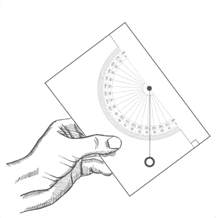 |


|
Purpose
The 'sand castles' activity will help students understand slope stability and how adding water to earth materials affects slope stability.
Make your own clinometer by gluing a protractor to a piece of cardboard, then threading a weighted string through the center. Your clinometer will help you measure slope angles as you build sand castles and models in these activities.
 |
Materials
Each group of students will need:
- One 1/2-gallon plastic bottle filled with dry sand,
- One plastic gallon-size tub,
- One foam cup with holes punched in the bottom (use a paper clip as a hole-punch),
- One graduated cylinder or measuring cup (something to measure the volume of water used during the activity),
- One ruler or yardstick, and
- One protractor with a piece of string and a small weight (or contact goniometer if available - used to measure the angle between mineral crystal faces).
|
Procedure
- Ask each group of students to build a sand castle in the plastic tub by using all the sand in the bottle. How tall can they make their castles? Encourage them to try different options with the dry sand, such as building the castle in the middle or against the side of the tub. Have them discuss the problems they encounter trying to build the tallest castle possible.
- Once they have experimented for several minutes, have the students measure the height of their castles with the ruler. Make sure students measure from the base of the castle to its tallest point, not the length of its slope. Have students report their measurements to the class.
- Have students brainstorm about how they might measure the slope angle. To measure the slope angle, students can construct a simple clinometer by using a protractor, a piece of string and some small weight, such as a nut or small bolt. Thread a weighted string (the string should be at least the same length as the straight edge of the protractor) through the pencil hole in the protractor. Glue the protractor to a piece of cardboard as shown in the illustration. Place the straight edge of the cardboard on the slope to be measured and read the angle of slope on the protractor scale. Have students record the slope angle.
- Challenge students to suggest ways they can make their castles higher. Invite them to think of any means possible, even using materials other than sand. Students may suggest such methods as building walls, bracing the sand, adding water to the sand, and adding other materials to the sand. Record these suggestions on chart paper so students can refer to them later.
- Have the students add water to the sand and, again, try to build a sand castle. Let them experiment until they are satisfied they have the highest possible castle. Collect height measurements from each group. Discuss the results of this second attempt to build the castle, then compare the wet sand castle heights to the dry sand castle heights. Have students calculate the average height of the dry sand castles and the average height of the wet sand castles.
- Ask, "Why do you think the wet sand castles are higher?" Students will realize that wet substances have different properties than dry ones. Ask students to think of other instances in which adding moisture changed the property of a dry substance, such as adding milk to flour when baking.
- Ask students what they think will happen if they add more water to their sand castles. Suggest that the groups 'rain' on their castles by filling the perforated Styrofoam cups with water and then letting the water rain on the castle. They should fill the perforated cups with 100 mL of water at a time so they can easily record the amount of water that caused the castle to slump.
- Have the groups observe how their castle changes as it becomes wetter. Students should describe these changes in their lab notebooks, as well as the amount of water they rained on the castle.
- Initially, the changes in the sand castles will be subtle. At some point the sand castle will slump, causing a landslide. When all of the sand castles have slumped, gather the class together to discuss their observations. Ask students how much water they had poured on the castle when it began to look like a liquid instead of a solid. Ask them where the castle failed first-the top, bottom, or middle?
Discussion
This activity is an excellent way to introduce concepts, such as erosion, geologic and hydrologic hazards, mass movements of earth materials (landslides) and water-earth interactions. Gravity provides the energy for landslides, but water also plays a number of roles. Small amounts of water added to the sand increase the cohesion of the sand grains - surface tension - as the water begins to fill pore spaces between the sand grains. As more water is added to the sand castle during the student-generated rain storm, the pore spaces fill with water and the force of the water actually pushes the sand grains apart, causing a landslide. Dry materials, such as sand, have a threshold of slope stability related to gravity and the cohesion of the material. Known as the angle of repose, this threshold limits the height of the castle for a given volume of sand.
Extension
- Discuss how the sand castles could be designed to prevent them from slumping. Ask students what methods they have observed of preventing walls from slumping. They might recall seeing retaining walls or terraces along rivers, streams, or highways.
- Build castles using other earth materials, then compare the height of these castles to the sand castles. Students can bring samples of soil from home.
- Explore how the rate of water flow affects erosion.
|
Teaching Guide |
Student Guide |
Download PDF
|
|
|
 |
|